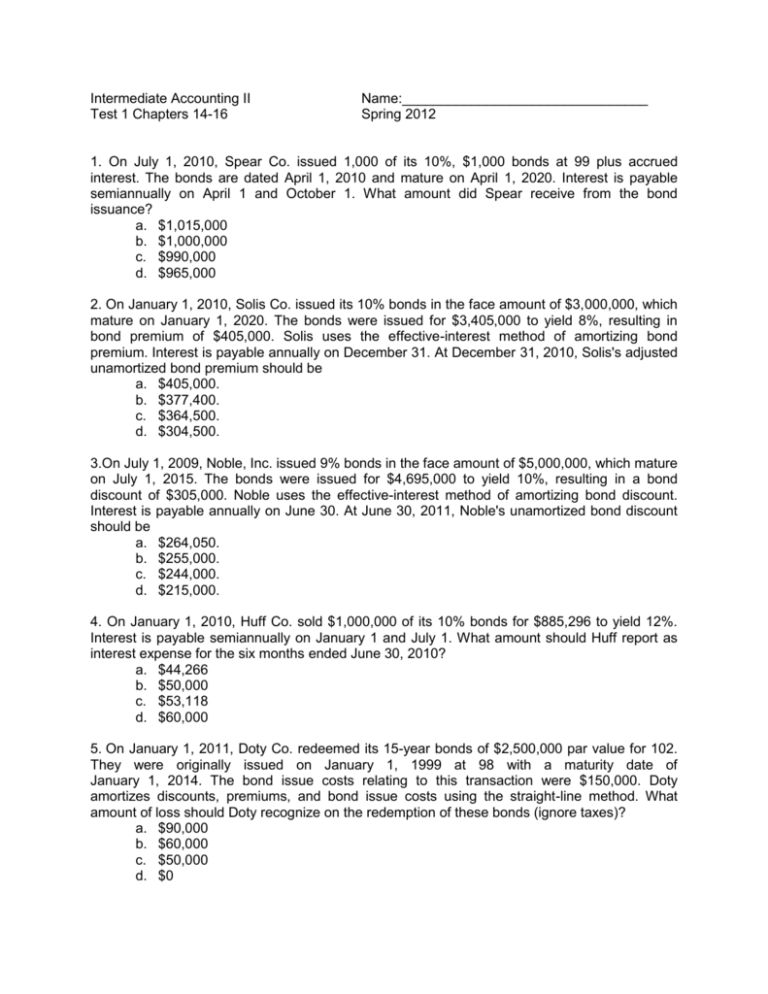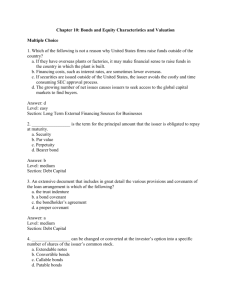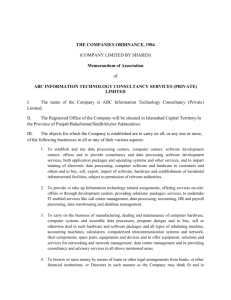Test 1
advertisement

Intermediate Accounting II Test 1 Chapters 14-16 Name:________________________________ Spring 2012 1. On July 1, 2010, Spear Co. issued 1,000 of its 10%, $1,000 bonds at 99 plus accrued interest. The bonds are dated April 1, 2010 and mature on April 1, 2020. Interest is payable semiannually on April 1 and October 1. What amount did Spear receive from the bond issuance? a. $1,015,000 b. $1,000,000 c. $990,000 d. $965,000 2. On January 1, 2010, Solis Co. issued its 10% bonds in the face amount of $3,000,000, which mature on January 1, 2020. The bonds were issued for $3,405,000 to yield 8%, resulting in bond premium of $405,000. Solis uses the effective-interest method of amortizing bond premium. Interest is payable annually on December 31. At December 31, 2010, Solis's adjusted unamortized bond premium should be a. $405,000. b. $377,400. c. $364,500. d. $304,500. 3.On July 1, 2009, Noble, Inc. issued 9% bonds in the face amount of $5,000,000, which mature on July 1, 2015. The bonds were issued for $4,695,000 to yield 10%, resulting in a bond discount of $305,000. Noble uses the effective-interest method of amortizing bond discount. Interest is payable annually on June 30. At June 30, 2011, Noble's unamortized bond discount should be a. $264,050. b. $255,000. c. $244,000. d. $215,000. 4. On January 1, 2010, Huff Co. sold $1,000,000 of its 10% bonds for $885,296 to yield 12%. Interest is payable semiannually on January 1 and July 1. What amount should Huff report as interest expense for the six months ended June 30, 2010? a. $44,266 b. $50,000 c. $53,118 d. $60,000 5. On January 1, 2011, Doty Co. redeemed its 15-year bonds of $2,500,000 par value for 102. They were originally issued on January 1, 1999 at 98 with a maturity date of January 1, 2014. The bond issue costs relating to this transaction were $150,000. Doty amortizes discounts, premiums, and bond issue costs using the straight-line method. What amount of loss should Doty recognize on the redemption of these bonds (ignore taxes)? a. $90,000 b. $60,000 c. $50,000 d. $0 6. On its December 31, 2010 balance sheet, Emig Corp. reported bonds payable of $6,000,000 and related unamortized bond issue costs of $320,000. The bonds had been issued at par. On January 2, 2011, Emig retired $3,000,000 of the outstanding bonds at par plus a call premium of $70,000. What amount should Emig report in its 2011 income statement as loss on extinguishment of debt (ignore taxes)? a. $0 b. $70,000 c. $160,000 d. $230,000 7. On June 30, 2011, Omara Co. had outstanding 8%, $3,000,000 face amount, 15-year bonds maturing on June 30, 2021. Interest is payable on June 30 and December 31. The unamortized balances in the bond discount and deferred bond issue costs accounts on June 30, 2011 were $105,000 and $30,000, respectively. On June 30, 2011, Omara acquired all of these bonds at 94 and retired them. What net carrying amount should be used in computing gain or loss on this early extinguishment of debt? a. $2,970,000. b. $2,895,000. c. $2,865,000. d. $2,820,000. 8. A ten-year bond was issued in 2009 at a discount with a call provision to retire the bonds. When the bond issuer exercised the call provision on an interest date in 2011, the carrying amount of the bond was less than the call price. The amount of bond liability removed from the accounts in 2011 should have equaled the a. call price. b. call price less unamortized discount. c. face amount less unamortized discount. d. face amount plus unamortized discount. 9. A corporation was organized in January 2007 with authorized capital of $10 par value common stock. On February 1, 2010, shares were issued at par for cash. On March 1, 2010, the corporation's attorney accepted 7,000 shares of common stock in settlement for legal services with a fair value of $90,000. Additional paid-in capital would increase on February 1, 2010 March 1, 2010 a. Yes No b. Yes Yes c. No No d. No Yes 10. On July 1, 2010, Nall Co. issued 2,500 shares of its $10 par common stock and 5,000 shares of its $10 par convertible preferred stock for a lump sum of $125,000. At this date Nall's common stock was selling for $24 per share and the convertible preferred stock for $18 per share. The amount of the proceeds allocated to Nall's preferred stock should be a. $62,500. b. $75,000. c. $90,000. d. $68,750. 11. Horton Co. was organized on January 2, 2010, with 500,000 authorized shares of $10 par value common stock. During 2010, Horton had the following capital transactions: January 5—issued 375,000 shares at $14 per share. July 27—purchased 25,000 shares at $11 per share. November 25—sold 15,000 shares of treasury stock at $13 per share. Horton used the cost method to record the purchase of the treasury shares. What would be the balance in the Paid-in Capital from Treasury Stock account at December 31, 2010? a. $0. b. $15,000. c. $30,000. d. $45,000. 12. In 2010, Hobbs Corp. acquired 9,000 shares of its own $1 par value common stock at $18 per share. In 2011, Hobbs issued 4,000 of these shares at $25 per share. Hobbs uses the cost method to account for its treasury stock transactions. What accounts and what amounts should Hobbs credit in 2011 to record the issuance of the 4,000 shares? a. b. c. d. Treasury Stock $72,000 $72,000 Additional Paid-in Capital $28,000 $96,000 $68,000 Retained Earnings $70,000 Common Stock $28,000 $4,000 $4,000 13. At its date of incorporation, Sauder, Inc. issued 100,000 shares of its $10 par common stock at $11 per share. During the current year, Sauder acquired 20,000 shares of its common stock at a price of $16 per share and accounted for them by the cost method. Subsequently, these shares were reissued at a price of $12 per share. There have been no other issuances or acquisitions of its own common stock. What effect does the reissuance of the stock have on the following accounts? a. b. c. d. Retained Earnings Decrease No effect Decrease No effect Additional Paid-in Capital Decrease Decrease No effect No effect 14. Farmer Corp. owned 20,000 shares of Eaton Corp. purchased in 2007 for $240,000. On December 15, 2010, Farmer declared a property dividend of all of its Eaton Corp. shares on the basis of one share of Eaton for every 10 shares of Farmer common stock held by its stockholders. The property dividend was distributed on January 15, 2011. On the declaration date, the aggregate market price of the Eaton shares held by Farmer was $400,000. The entry to record the declaration of the dividend would include a debit to Retained Earnings of a. $0. b. $160,000. c. $240,000. d. $400,000. 15. A corporation declared a dividend, a portion of which was liquidating. How would this distribution affect each of the following? a. b. c. d. Additional Paid-in Capital Decrease Decrease No effect No effect Retained Earnings No effect Decrease Decrease No effect 16. On May 1, 2010, Ziek Corp. declared and issued a 10% common stock dividend. Prior to this dividend, Ziek had 100,000 shares of $1 par value common stock issued and outstanding. The fair value of Ziek 's common stock was $20 per share on May 1, 2010. As a result of this stock dividend, Ziek's total stockholders' equity a. increased by $200,000. b. decreased by $200,000. c. decreased by $10,000. d. did not change. 17. How would the declaration and subsequent issuance of a 10% stock dividend by the issuer affect each of the following when the market value of the shares exceeds the par value of the stock? Additional Common Stock Paid-in Capital a. No effect No effect b. No effect Increase c. Increase No effect d. Increase Increase 18. Didde Co. had 300,000 shares of common stock issued and outstanding at December 31, 2010. No common stock was issued during 2011. On January 1, 2011, Didde issued 200,000 shares of nonconvertible preferred stock. During 2011, Didde declared and paid $100,000 cash dividends on the common stock and $80,000 on the preferred stock. Net income for the year ended December 31, 2011 was $620,000. What should be Didde's 2011 earnings per common share? a. $2.07 b. $1.80 c. $1.73 d. $1.47 19. At December 31, 2011 and 2010, Miley Corp. had 180,000 shares of common stock and 10,000 shares of 5%, $100 par value cumulative preferred stock outstanding. No dividends were declared on either the preferred or common stock in 2011 or 2010. Net income for 2011 was $400,000. For 2011, earnings per common share amounted to a. $2.22. b. $1.94. c. $1.67. d. $1.11. 20. Marsh Co. had 2,400,000 shares of common stock outstanding on January 1 and December 31, 2011. In connection with the acquisition of a subsidiary company in June 2010, Marsh is required to issue 100,000 additional shares of its common stock on July 1, 2012, to the former owners of the subsidiary. Marsh paid $200,000 in preferred stock dividends in 2011, and reported net income of $3,400,000 for the year. Marsh's diluted earnings per share for 2011 should be a. $1.42. b. $1.36. c. $1.33. d. $1.28. 21. Foyle, Inc., had 560,000 shares of common stock issued and outstanding at December 31, 2010. On July 1, 2011, an additional 40,000 shares of common stock were issued for cash. Foyle also had unexercised stock options to purchase 32,000 shares of common stock at $15 per share outstanding at the beginning and end of 2011. The average market price of Foyle's common stock was $20 during 2011. What is the number of shares that should be used in computing diluted earnings per share for the year ended December 31, 2011? a. 580,000 b. 588,000 c. 608,000 d. 612,000 22. When computing diluted earnings per share, convertible securities are a. ignored. b. recognized only if they are dilutive. c. recognized only if they are antidilutive. d. recognized whether they are dilutive or antidilutive. 23. In determining diluted earnings per share, dividends on nonconvertible cumulative preferred stock should be a. disregarded. b. added back to net income whether declared or not. c. deducted from net income only if declared. d. deducted from net income whether declared or not. 24. The if-converted method of computing earnings per share data assumes conversion of convertible securities as of the a. beginning of the earliest period reported (or at time of issuance, if later). b. beginning of the earliest period reported (regardless of time of issuance). c. middle of the earliest period reported (regardless of time of issuance). d. ending of the earliest period reported (regardless of time of issuance). 25. The following information was extracted from Smurm Corporation's 2002 annual report: Common stock Shares outstanding 12/31/01 90 million New shares issued 4/1/02 10 million Shares outstanding 12/31/02 100 million Preferred stock $10 par, 10%, convertible into 2 shares of common stock, shares outstanding 50 million Options 1 million options, each to purchase one common share at $50 per share Market price of stock Average for year $75 Beginning of year $70 End of year $78 Preferred dividends paid $50,000,000 Net income for 2002 $350,000,000 Using the treasury stock method, the options would result in how many extra shares being recognized in the diluted EPS calculation? a. 500,000 b. 358,975 c. 333,333 d. 285,714









